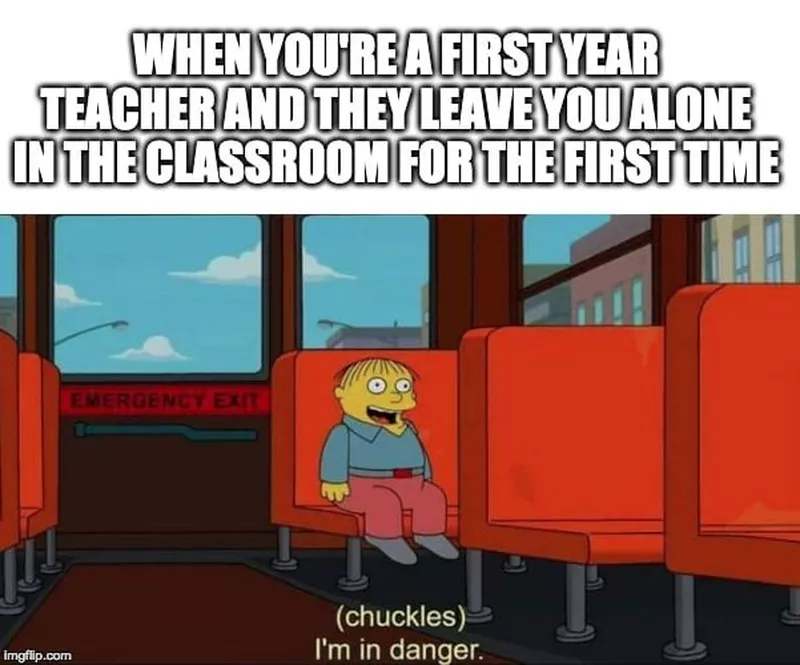
District Administrators: For credit information on our courses, please see our University Credits, Units, and Transcripts page.
I still remember my first year teaching like it was yesterday. Like many of us, I became a teacher through an alternative pathway. I applied to begin an Intern Teaching Program in May of one year and by August I was standing in front of 32 9th graders expecting to be taught Biology when I had never done anything like it before.

First Day Preparation
I spent days/weeks prepping my classroom before that first day. I set up turn in bins by the door of my room, thinking it would be really easy for students to turn in work as they both entered and left the room (I love efficiency!). I used painters tape to organize one of my whiteboards into a place I’d write out my objectives each day. I made a plan for what I was going to be doing for essentially every minute of that first class period, and I tried to think of EVERYTHING. What if someone is late? What if someone is in the wrong classroom? What if I have behavior problems? What if someone needs to use the bathroom? What if someone isn’t on my roster? What if someone doesn’t speak English and I wasn’t told beforehand? You get the picture. I. felt. so. prepared.
First Lesson in Teaching: You Can't Prepare for Everything
Despite all that preparation, I learned my first lesson in teaching that day in the first 5 minutes. Because I was such a recent new hire, my students had someone else’s name listed on their class schedules. The large sign I made that said “Welcome to Ms. Harrison’s class!” to avoid any confusion when students were searching for my room, ended up confusing every student I had.
About 3 minutes into the 5 minute passing period, I still had zero students in my room. My pre-planned itinerary for the period allowed me some flexibility (I prepared for surprises, too!), but I still only had about 4 minutes allocated for that.
Anyways, it was right about this time that a brave student came over and showed me their schedule that I realized what was happening. My careful plan inspired by Harry Wong’s book The First Days of School to welcome each student individually, ask for their name, tell them where to sit and what to do, then move on to the next one was about to have to go into overdrive if I wanted my schedule to work. I had 32 students to do that with, now all in under 2 minutes. Surprise: It took 10.
All in all, I ended up getting through about 3/4 of the activities of I had wanted to, I forgot to enter attendance for periods 1 and 3, and I ran out of water to drink at about noon (I brought 3 bottles with me… and it still wasn’t enough!!). I also realized that although my placement of the turn in bins was definitely efficient, it also meant that whenever the door opened, wind would blow the papers inside the bins around the room. I couldn’t make this stuff up if I tried!!
Moral of the story? Prepare as best you can, then forgive yourself for mistakes.
During my first 3 years of teaching, I dedicated a lot of time to learning how to become a better teacher. I read articles, blogs, books, online forums, whatever I could get my hands on that was highly recommended. The fact of the matter is, though, that a lot of it was like throwing pasta at the wall and seeing which stuck, and a lot of my “improvements” were reactive as opposed to preventative.
Wherever you are at in your new teacher journey, check out some of the links below. These resources saved my sanity during my first few years of teaching. If you are an overwhelmed new teacher about to start the school year, I suggest starting with The First Days of School and then watching Mr. Hester’s example videos.
New Teacher Resource List
Second Lesson in Teaching: Don’t Reinvent the Wheel!
- The First Days of School by Harry Wong
- The Classroom Management Book by Harry Wong
- Mr. Hester’s example videos for the first day and second day of school and what setting expectations and teaching routines LOOKS like 🎥
- Mr. Hester’s sample procedure handout – scroll down to the “Classroom Resources” section📝
- Smart Classroom Management Blog by Michael Linsin 📝
- Smart Classroom Management classroom management plans- Elementary and High School
- Alice Keeler (teacher technology tips) 📝
- Teach Like a Champion 3.0 by Doug Lemov
- The Teach Like a Champion blog 📝
- Grading for Equity by Joe Feldman
Related Salary Advancement Courses:
Jennica
Hey there! My name is Jennica and I am a classroom educator with experience teaching a wide-range of science classes at the high school level. For more information about me please see the ABOUT section of our site.Download our Advancement Tracker!
Enter your email address below to download a copy of our Salary Schedule Advancement Tracker and opt in to receive emails from Cathy and Jennica.
© Copyright JIR Enterprises, Inc. Site design by Make Waves Design. Ongoing customization by Jennica Harrison.
